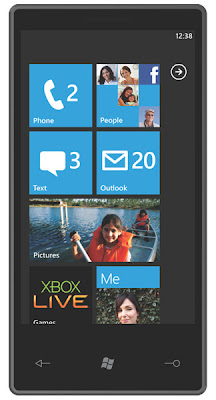Windows Phone 7 Series

Microsoft just planted a massive flag in the ground with the debut of Windows Phone 7 Series. The company's new mobile operating system is a radical and potent departure from the past, and there's a lot to take in, so I have researched a bit about the phone. This is what its got.
For a start, the basic fact is that Windows Phone 7 Series is the successor to Microsoft's line of Windows Mobile phone operating systems. It's based on the Windows CE 6 kernel, like the Zune HD, while current versions of Windows Mobile are based on Windows CE 5. Microsoft announced the new OS at Mobile World Congress 2010 in Barcelona, and says that the first handsets to run it are supposed to be released by the third quarter of this year.
The visual and underlying differences in the operating system are almost too numerous to mention, including a completely (and we do mean completely) upended user interface, an emphasis on finger-based touchscreen input, deep social networking integration, fully branded and expansive Zune and Xbox components, and extremely strict hardware requirements for partners. A couple familiar touchstones from the past include plans for Outlook and Office support, as well as licensing to a wide variety of third party hardware vendors -- despite the name change, Microsoft still isn't building any phones itself.
Part of what makes Windows Phone 7 Series a departure for Microsoft is that the company is taking a much bigger role in dictating what hardware is allowed to run the OS. While we still haven't seen an actual device produced by a manufacturer for retail (the demo unit being shown off is a prototype slab allegedly made by Garmin-Asus, but not a device that might ever come to market), Microsoft has a very clear picture of what they want these units to be built like. Still, while the company is laying down the ground rules in an attempt to create a more consistent experience across phones, it doesn't mean there won't be variety. You'll see variation in devices (yes, some with and some without a keyboard), but there will be a much more steady tone in the nature of Windows Phone 7 Series handsets. Here's a look at some of the minimum specs detailed to us thus far:
* Large WVGA screen with a single aspect ratio (which means BlackBerry-style devices won't be readily available to begin with)
* Five specific hardware buttons required: Start, back, search (a dedicated Bing button), camera button, and power -- no more, no less
* Capacitive multitouch
* CPU and GPU requirements (beginning with Qualcomm's Snapdragon as the go-to processor)
* WiFi
* AGPS
* Accelerometer
* FM radio
* High resolution camera
So, how exactly is Windows Phone 7 Series different than previous versions of Windows Mobile? The question is probably better phrased as "how isn't Windows Phone 7 Series different than previous versions of Windows Mobile." This isn't a coat of paint or a touch up -- this is a full-scale nuclear assault on everything you knew about Windows on phones. Basically, every interface paradigm you've seen in earlier versions is obliterated here, and the design has been utterly decimated (in a very, very good way). There's no longer a Start menu, drop downs, check boxes, radio buttons, windows, lists of icons... we could go on and on, but suffice to say this thing is just a totally different beast altogether. Microsoft clearly worked long and hard developing new ways to navigate a phone, and this doesn't even bear a resemblance to other phones currently on the market. There are no icon grids, no pull down menus, no card view, and no task manager (more on that in a moment). Microsoft is destined for success with this as it partners with hardware manufactures and service providers around the world. As some one from this part of the world, my only worry is how soon will it be for the products to reach Africa and the issue of pricing.
I windows phone is highly recommended for cooperates and if you wanna synchronize your windows based PC with your phone and work from anywhere using you phone.

Comments
Post a Comment
Be sure to check back again because I do make every effort to reply to your comments here. Karibu :)